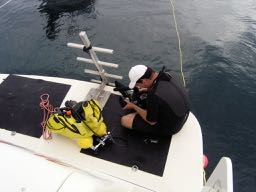 I was covering a story in the Upper Peninsula of Michigan when I met, singer/songwriter, Carl Behrend. I was interviewing him about waterfalls and Great Lakes legends when he revealed to me that he was also the author of the novel “The Christmas Tree Ship”.
I was covering a story in the Upper Peninsula of Michigan when I met, singer/songwriter, Carl Behrend. I was interviewing him about waterfalls and Great Lakes legends when he revealed to me that he was also the author of the novel “The Christmas Tree Ship”.
I had to admit that I had never heard of the Christmas tree ship. As it turns out, the Christmas tree ship, better known as the “Rouse Simmons” is one of the fastest growing, and beloved stories of tragedy on the great lakes. A story, in fact, so intriguing, that we could not pass up the opportunity to produce a story on it for the Wild Weekend television program.
The Rouse Simmons was a three masted schooner that sailed Christmas trees from the Upper Peninsula of Michigan to Chicago, IL. As the story is told, the ship was one of just a few other ships that did the same. You see, having a Christmas tree was a honored thing to the German population of Chicago at the turn of the century. Every holiday season, patrons would anxiously scurry to the harbor to purchase their perky pines from one of the ships that completed the treacherous journey.
The Rouse Simmons was especially endeared to the residents of Chicago. She was captained by a rather vibrant and flamboyant fellow by the name of Herman Schuenemann. Schuenemann was an entrepreneur who dabbled in a bit of everything. His passion, however, was the trees. He coveted the holidays and reveled in being the favorite stop for his patrons.
Captain Schuenemann also understood the art of showmanship. He was credited with being the first one to decorate his ship with colored lights once in the harbor. But even before reaching the harbor his keen sense of marketing was put to use. Each time the Rouse Simmons neared the Chicago harbor Schuenemann made it a tradition to place a Christmas tree high atop the tallest mast. It was that tree that inevitably became the “golden egg” of trees and commanded the highest price. Pictures seen today of the Rouse Simmons always include the tree lashed to the mast.
November was the season for transporting trees. Cutting the tress any time sooner would guarantee dead and drooping limbs, anything later may result in the risk of a frozen lake Michigan. November is also the season for Great Lakes gales. Through the years, thousands of ships have been mercilessly sucked to the depths of the icy waters only to be seen again by adventurous scuba divers. The Rouse Simmons was to be no exception.
On the afternoon of November 21st Captain Schuenemann left port in Thompson Michigan burdened with over 5,500 trees. The weather predicting equipment at the turn of the century, by today‘s standards, was less than accurate and the captain and crew had no idea that they were sailing into a storm that would eventually lead to their demise. Lore has it that the only indication that trouble may loom was the sighting of mice evacuating the ship just before departure.
The storm quickly consumed the Rouse Simmons. There were reports of seeing the ship from many of the Wisconsin ports along its journey, but none reported seeing any signs of distress. The weather continued to deteriorate and so did the toll on the 44 year old vessel. Howling wind and freezing temperatures made the masts, ropes and mostly the trees an easy target for ice build up.
What made maters worse is the fact that the ship had been overloaded with trees. So many trees in fact, that the ice build up on the branches made the 153ft. ship extremely top heavy. The crew was ordered to start cutting trees loose and putting them overboard to compensate.
Many fishing boats, headed for safe harbor, saw the Simmons but once again, there were no reports of distress from Schuenemann’s boat. Upon reaching the port of Kewaunee, WI., the distress flags were finally spotted by the life saving service. The sails were tattered and whipping furiously in the wind. Yet still, the Simmons continued to sail west towards Chicago without pulling into the Kewaunee harbor.
The Kewaunee Life Saving Service’s power launch was under repair and they had nothing but row boats to try to reach the Simmons. With the weather being as 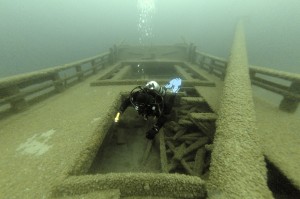 ferocious as it was, the Kewaunee lifesavers new they had no chance of catching the Simmons. They then called the Life Saving station in Two Rivers Wisconsin to intercept the vessel.
ferocious as it was, the Kewaunee lifesavers new they had no chance of catching the Simmons. They then called the Life Saving station in Two Rivers Wisconsin to intercept the vessel.
Immediately the Two Rivers service dispatched their power launch rescue boat. For a period of time the rescuers could see the ship but the fate of the Simmons was to be their destiny. A snow squall slowly engulfed the shadowy outline of the vessel and the Rouse Simmons was to never be seen again. Above water, that is.
Since that time many stories, myths, and theories have surfaced concerning the untimely demise of the Simmons. These stories and reports can all be found if you go to our web link page and look at “Diving” and then “Christmas Tree Ship“.What we have found in researching, diving the wreck, and filming a documentary on the “Rouse Simmons” is the following:
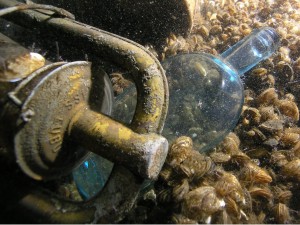 The Simmons rests in 160 feet of water within site of Two Rivers Wisconsin. The boat is fully in tact and in fantastic condition. If you are fortunate enough to dive the remains, you will find the Christmas trees still in the hold with needles still on the branches.
The Simmons rests in 160 feet of water within site of Two Rivers Wisconsin. The boat is fully in tact and in fantastic condition. If you are fortunate enough to dive the remains, you will find the Christmas trees still in the hold with needles still on the branches.
Fishermen found the steering wheel nearly a mile from the actual wreck site. It is now believed that the reason that the Simmons did not turn into port is that a piece of the mast broke, crashed into the steering mechanism, and made it impossible to steer the boat.
Reports were that there was a note found in a bottle the following spring written by the captain that read “Friday…everybody goodbye. I guess we are all through. During the night the small boat washed overboard. Leaking bad. Invald and Steve lost too. God help us”. Many people to this day dispute the authenticity of the note but one thing is for sure. Note or no note, the result was the same. Lives were lost in order to bring the spirit of Christmas to the residents of Chicago.
To this day the U.S. Coast guard still brings a load of trees to the Chicago harbor to carry on the Schuenemann tradition. This year, the newest Coast guard vessel “Mackinaw” will dawn the trees on its decks. If you are lucky enough to get one of these trees, you now have a great story to go along with it.

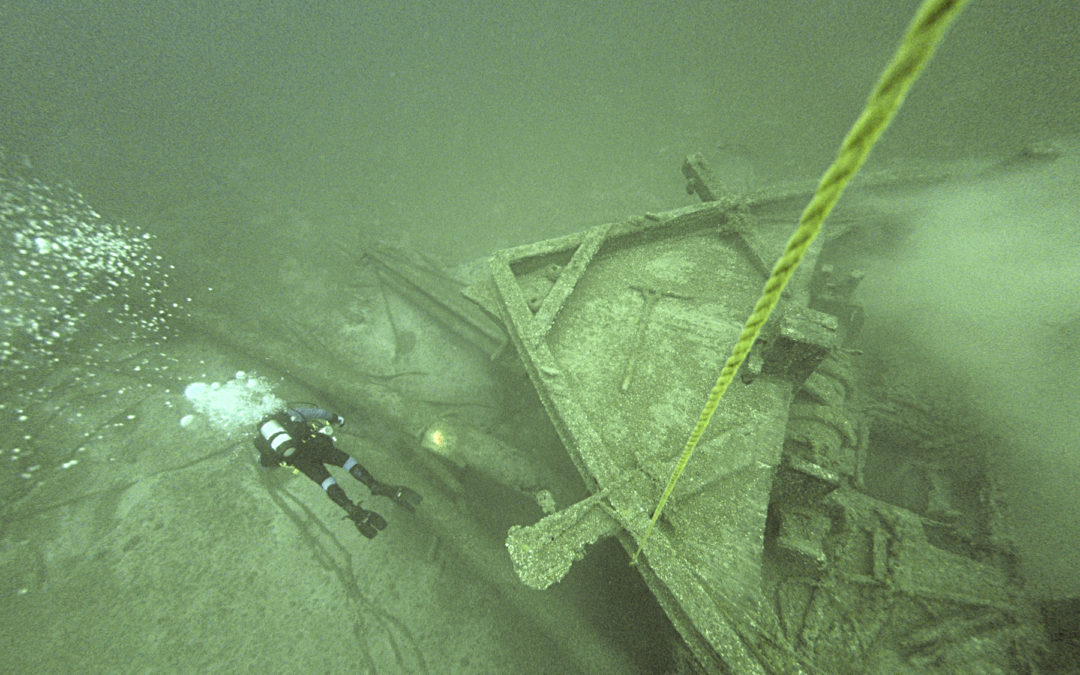
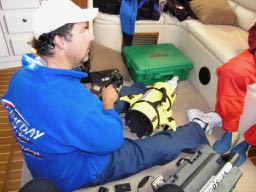 .
. 